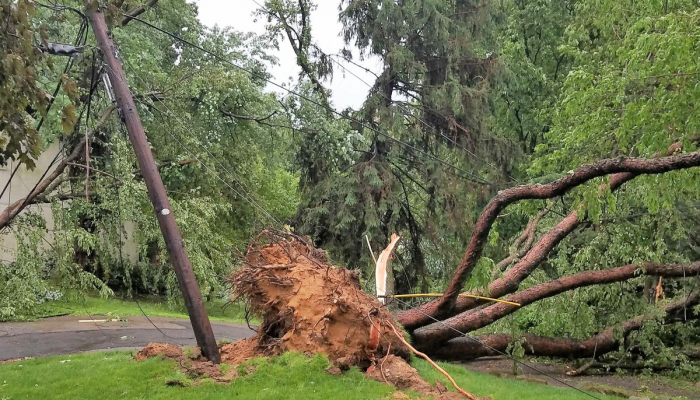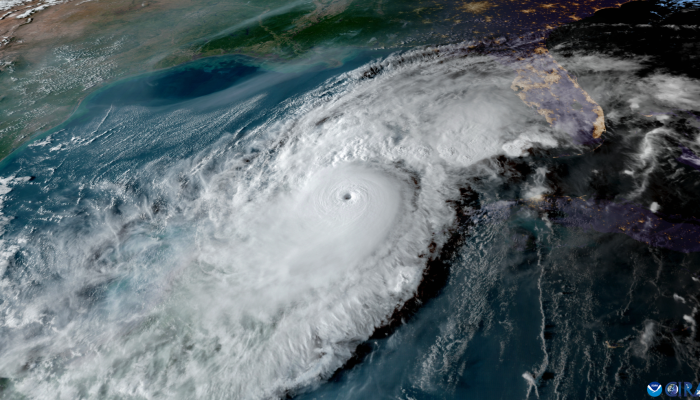Here at OEM (the Philadelphia Office of Emergency Management), we love to use acronyms and highfalutin words, like mitigation (an action to reduce risk).
Sometimes these acronyms and words can be overwhelming, especially when educating yourself on emergencies.
So, we thought we’d break down some of our most commonly used terms when it comes to severe weather.
Flooding is the most common natural hazard in Philadelphia likely to affect you, so we paid extra attention to flooding terms you’re likely to hear.
Defining flooding and other severe weather terms will give you a better insight into how to protect yourself, your property, and your loved ones.
Severe weather terms
100-year flood: A term to describe a flood having a 100-year recurrence interval. Misinterpretation of this terminology often leads to confusion about flood recurrence intervals, the average number of years between floods of a certain size is the recurrence interval or return period. The actual number of years between floods of any given size varies a lot because of the naturally changing climate. Instead of the term “100-year flood,” a hydrologist (scientist who studies water) would rather describe this extreme hydrologic event as a flood having a 100-year recurrence interval.
Coastal flooding: When a hurricane, tropical storm, or heavy rainfall to our north creates waters to rise and a surge along the tidal Delaware River.
Emergency alerts: When hazardous weather is approaching or dangerous conditions are occurring, local authorities, like OEM or the National Weather Service, may issue information alerts that come to your phone, TV, or radio.
- Emergency alert system: EAS is the national public warning system used by state and local authorities to deliver important emergency information, such as weather and AMBER alerts. EAS participants — radio and television broadcasters, cable systems, satellite radio and television providers, and wireline video providers — deliver local alerts on a voluntary basis, but they are required to provide the capability for the U.S. president to address the public during a national emergency.
- Wireless emergency alert: The WEA system delivers critical warnings and information to the public on their wireless devices. Authorized public safety officials send the alerts through FEMA’s Integrated Public Alert and Warning System (IPAWS) to wireless providers, which then push the alerts from cell towers to mobile devices in the affected area. The alerts appear like text messages on mobile devices.
- ReadyPhiladelphia: The City of Philadelphia’s mass notification system. Enrollees get important information direct from OEM. You can get free text alerts by sending READYPHILA to 888-777 or customize your text/email alerts for information (like river flood stages) and locations important to you.
Flash flooding: Flooding that begins within six hours, and often within three hours, of heavy rainfall. Urban areas, like Philadelphia, are more prone to flash flooding due to lesser vegetation and more run-off that can overwhelm sewage systems. It does not have to rain in our area for a flash flood alert to be issued.
Flood alerts: The National Weather Service will issue information for awareness or warning purposes when flooding is a threat.
- Flood watch: Flooding is possible, be prepared.
- Flood advisory: Flooding is imminent, use caution.
- Flood warning: Flooding is happening, take action.
Floodplain: The floodplain is the relatively flat lowland that borders a river, usually dry but subject to flooding. Floodplain soils actually are former flood deposits.
Flood insurance: Flood insurance is not covered under your homeowner’s policy or renter’s insurance. It typically takes time to go into effect when added. You need separate flood insurance that covers the damage to your property caused by flooding. Start by talking to your insurance agent to see what is covered in your policy.
Flood prone: Know flooding hazards in your area or where you’re traveling. Don’t park your vehicle in a low-lying area, like an underpass. The National Weather Service (NWS) Advanced Hydrological Prediction Service issues river flooding guidance for rainfall events based on river flood gauge readings.
Flood risk: A property’s Flood Factor is not only a score ranging from 1–10, it is a comprehensive risk assessment including a property’s 30-year risk of flooding from high-intensity rainfall, overflowing rivers and streams, high tides, and storm surge. FEMA updated the National Flood Insurance Program (NFIP) to deliver more equitable flood insurance pricing that better reflects a property’s actual flood risk. This program is called Risk Rating 2.0!
Heat health emergency: Very hot weather can make people sick, even healthy adults. Older adults, pregnant women, infants and young children, and people with medical conditions are at higher risk. Pets can also be at risk. Hot weather can also cause utility disruptions or bad weather. During very hot weather, the City can declare a heat health emergency where a special response and actions follow to help residents.
Hurricane: A hurricane is a tropical cyclone that has maximum sustained surface winds of 74 mph or greater. This differs from a tropical storm, which has maximum sustained surface winds ranging from 39–73 mph. Atlantic hurricane season runs from June 1 through November 30.
Power outage: Severe storms with high winds can cause prolonged outages with downed power lines. Our regional power provider, PECO, has information for before, during, and after the storm, including how to report and track outages.
Riverine flooding: When water levels rise in rivers, creeks, and streams and overtop their banks. You can check current and forecasted water-levels on the National Weather Service’s website.
Thunderstorms: Intense storms that can bring heavy rainfall, high winds, hail, tornadoes, and lightning. Lightning is a leading cause of injury and death from weather-related hazards.
Tornadoes: Violently rotating columns of air that extend from a thunderstorm to the ground.
Turn around, don’t drown: A phrase to remind you to NEVER drive through flooded roads. As little as six inches of water can cause you to lose control of your vehicle. Twelve inches can carry away a car.
Stay connected with us year-round!
Follow us on Facebook and Twitter for timely information, safety tips, and alerts on flooding and severe weather.
Get severe weather safety and helpful preparedness tips sent straight to your inbox every month. Sign up for our ReadyPhiladelphia newsletter.




